by
T. Diouf and J.B. Amon Kothias
Tunas and related species comprise a single family (Regan, 1909): the family Scombridae (figure 2.1) characterized by the mode of insertion of the caudal fin rays.
This family, composed of 15 genera and 49 species, is subdivided in two sub-families: the Gasterochismatinae (a single species) and the Scombrinae. In the sub-family Scombrinae, there are four tribes separated according to characteristic internal bones (Collette and Chao, 1975; Collette and Russo, 1979). These four tribes can be divided in two groups: that of the Scombrini and Scomberomorini, the more primitive group, and that of the of Sardini and Thunnini.
The tribe Thunnini is more evolved and the four genera of which it consists are, among the bony fishes, the only ones to posses a temperature regulating circulatory system that permits them to conserve a part of their metabolic heat; this faculty explains why they are widespread in all oceans.
The morphological characteristics of the species in this family can be summarized as follows:
Elongated fusiform body, moderately compressed in several genera. Pointed rostrum; adipose fin occasionally present (Scomber). Two dorsal fins; the anterior fin generally short and separated from the posterior fin; pinnules present behind the dorsal and the anal; pectorals placed high; pelvics moderate or small; tail deeply forked. At least two small keels on each side of the caudal peduncle, one keel larger in many species. Lateral line simple. Body may be covered uniformly with small to moderate scales (for example, Scomber, Scomberomorus) or may bear a developed corselet (region behind the head and surrounding the pectoral fins covered in thick scales of moderate size) and the rest of the body naked (Auxis, Euthynnus, Katsuwonus), or covered in small scales (Thunnus).
Coloration: several species of Scomber are generally bluish or greeninsh below with a system of wavy bands above the flanks and golden above; Scomberomorus and Acanthocybium gray-blue below and golden above with vertical bars or dark spots on the sides. Sarda posses 5 to 11 oblique dark bands on the back; Euthynnus possess a system of bands on the back and many dark spots between the pectorals and the pelvics; Katsuwonus has 4 to 6 prominent longitudinal bands on the ventral surface; Auxis and Thunnus are blue-black, darkened above; the majority of the Thunnus species have bright yellow pinnules with black edges.
All fish composing the family Scombridae are marine and epipelagic; they live in midwater in the upper layer (from 0 to 300 m) and make occasionally important trophic or reproductive migrations.
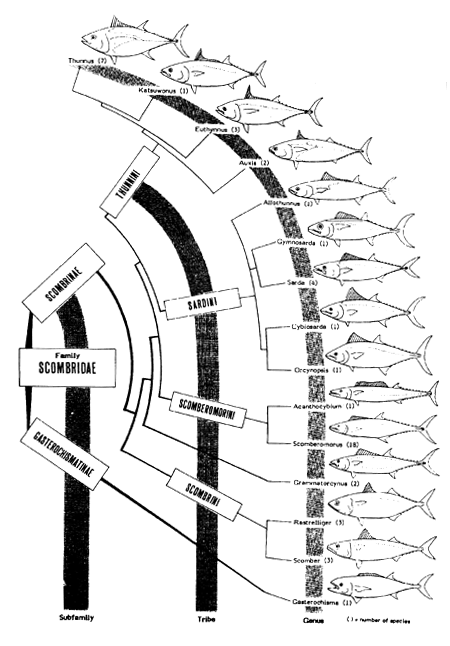
Figure 2.1 Classification of tunas within the family scombridae (Collette and Nauen, 1983).
 | 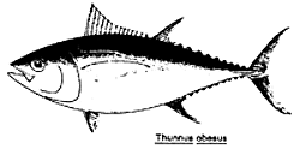 |
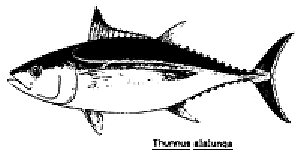 | 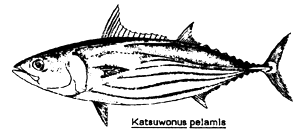 |
Figure 2.2 Principal species of large tunas present in the study area (Collette and Nauen, 1983).
In the waters of the eastern tropical Atlantic, object of the present study, 12 species are more or less actively exploited. These will only be summarily presented here but more complete descriptions may be found in: Postel (1950, 1955); Cadenat (1950); Blache et al. (1970), Collet and Chao (1975) Miyake and Hayasi (1978); Collette and Russo (1979); Fisher et al. (1981), Seret and Opic (1981); Collette and Nauen (1983).
The rays of the second dorsal and anal fins of the yellowfin are longer than those of other species. The flanks and ventral surface carry about 20 almost vertical more or less dotted lines. In the eastern Atlantic, the yellowfin is known from the Azores to South Africa. The common sizes lie between 35 and 180 cm fork length, that is between 0.8 and 111 kg.
The bigeye tuna is distinguished from the yellowfin by a squat body and large sized eyes in adults. The second dorsal and anal are never as developed as those of the yellowfin. On the other hand, the pectorals are long; they pass the level of the second dorsal in young individuals. The bigeye is often considered as a temperate species from the fact that adults prefer to stay in cold waters. Sizes are frequently between 35 and 190 cm fork length, that is between 0.9 and 146 kg.
The yellowfin and bigeye juveniles are very close in form and coloration; they are thus very difficult to recognize, except by trained observers. The following criteria, however, permit adequate distinction of the 2 species:
the liver of the bigeye is striated while that of the yellowfin is smooth.
the nasal fossa of the yellowfin in the Eastern Atlantic always contains a parasitic worm of the type Nasicola klawei (paragraph 6.1.8), while those of the bigeye never contain this parasite.
the ventral rays are different in the 2 species: in the yellowfin an alternation of continuous and dotted striations is observed, curved towards the rear; in the bigeye the striations are continuous and straight. This criterion is however only usable for fresh individuals in good condition.
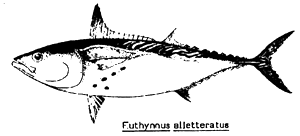 |  |
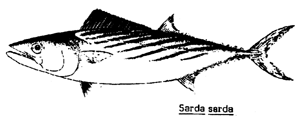 |  |
 |  |
Figure 2.3 Principal species of small tunas present in the study area (Collette and Nauen, 1983).
The skipjack has a rounded body without scales except for the corselet and the lateral line. It is characterized by 4 to 6 dark longitudinal bands which cross the lower flank and abdomen; in living individuals, these bands appear as discontinuous lines of dark spots. Cosmopolitan in tropical and subtropical seas, the skipjack is found along the entire length of the west african coast. The predominant fork lengths lie between 30 and 80 cm, that is between 0.5 and 11.5 kg.
The albacore is characterized by a body elevated at the level of the second dorsal, remarkably long pectorals, which extend well past the second dorsal, and caudal with white posterior margin. Cosmopolitan species in temperate waters, the albacore is divided into two stocks, north and south, in the Atlantic. Common sizes are between 35 and 110 cm in fork length.
The bluefin tuna is a large sized species which is found predominantly in the temperate and cold regions of the north Atlantic (Norway, Morocco, Canada, Canaries …) and south Atlantic (coasts of Brazil, Argentina, South Africa …); it is thus located essentially outside of the study area.
The spotted tunny or little tuna has a naked body with the exception of the corselet and lateral line. The two dorsal fins are practically contiguous; the anterior spines of the first dorsal, being much higher than the following ones, give the first dorsal a strongly concave profile. The back shows irregular blotches on the anterior two thirds of the body; these do not extend ahead of the region of the first dorsal; the flanks and abdomen are silver-gray with 1 to 7 characteristic black spots at the level of the thorax between the pectoral and the pelvic.
In the east Atlantic, the spotted tunny is distributed evenly from the Morocco coast to the Angola coast; it is found generally in littoral waters near snoals, small islands, etc. …. Common sizes are between 30 and 70 cm in fork length, that is between 0.5 and 5.5 kg.
The auxids are the smallest fish of the tribe Thunnini. The genus Auxis contains two species: Auxis thazard (Lacépède, 1803), the frigate tuna, and Auxis rochei (Risso, 1810), the bullet tuna, which are distinguished from other species of tuna by their separated dorsal fins. They have rounded bodies, naked except for the corselet, the posterior part of which is narrow in Auxis thazard and wide in Auxis rochei; the bands and dark lines above the lateral line are oblique or horizontal in the former and almost vertical in the latter.
Auxis thazard appears to be the most common of the two species. Largely distributed in warm waters, it seems more oceanic than the other minor tunas (spotted tunny, atlantic bonito, etc. …). The most frequent sizes are between 0.4 and 3 kg.
The Atlantic bonito has 5 to 11 dark stripes, oblique, rarely horizontal, that decorate the back with a series of interlocking V's opening towards the front when looking at the fish from above. It is entirely covered by miniscule scales over the whole body, and developed at the level of the corselet.
The Atlantic bonito is widespread in the tropical and sub-tropical regions where it lives in waters over the continental shelf. The range of sizes extends from 30 to 50 cm in fork length.
(syn.: Cybium tritor, Blache et al., 1970)
The west African Spanish mackerel has a particularly laterally compressed body; it is entirely covered in small scales, without distinct corselet. The lateral line is sinuous and curves gradually towards the caudal peduncle. The jaws lined with prominent teeth are very cutting. The first dorsal fin is black with a white posterior base; the flanks bear approximately 3 rows of round or oval spots.
The Western African spanish mackerel appears to have a restricted distribution in a narrow coastal band of the west African littoral; it is the only species capable of entering lagoons. The common sizes are from 30 to 90 cm in fork length, that is between 0.2 and 6 kg.
The wahoo is recognizable by its very elongated body similar to a pike with numerous dark vertical bars on the sides which reach just below the lateral line. This is a species of large size which may attain 2 meters in fork length. It frequents warm waters of the tropical eastern Atlantic.
The plain bonito has a strongly laterally compressed body, naked with the exception of the corselet covered in large scales. The lateral line is well marked; the first dorsal fin is black except for the last 3 rays which are white. The young individuals of less than 30 cm are marked by spots irregularly distributed on the back and flanks. The plain bonito is a warm water species which is abundant in the tropical eastern Atlantic.
The chub mackerel (also known as Spanish mackerel) has an eye endowed with a fatty eyelid; it does not possess a median keel on the caudal peduncle and the has a back striped with undulating dark bands while the flanks and abdomen bear numerous rounded spots.
Billfish constitute a non-negligible component of the species exploited by certain tuna fisheries; they are grouped in two families:
the xiphiidae with a single genus, Xiphias;
the istiophoridae with three genera: Makaira, Tetrapturus and Istiophorus.
These genera are widely represented in the Atlantic in the tropical and sub-tropical waters (figure 2.4). The most common species are:
Unique representative of the family, the swordfish bears only one very strong keel on each side of the caudal peduncle; it is easily recognized by its very well developed dorso-ventrally flattened rostrum. The caudal fin changes form with age. The swordfish may reach 350 cm in length, but usual sizes lie between 100 and 220 cm.
The atlantic sailfish is identifiable by its long and very tall first dorsal, reaching its maximum height in its middle: the “sail”, cobalt blue, studded with numerous small black spots. The species reaches 300 cm in length.
The atlantic blue marlin has a long low first dorsal, except for the anterior part where it presents a high pointed lobe; lateral line consists of a network. The blue marlin is one of the largest marlins; it reaches 400 cm in length.
The black marlin is distinguished from the preceding species by its rigid pectoral, incapable of folding toward the flanks.
The white marlin has the first dorsal higher in front; it diminishes rapidly towards the rear. This species reaches 300 cm in length.
The longbill spearfish has an extremely compressed body with first dorsal relatively tall. Lengths commonly reach 200 cm.
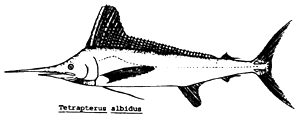


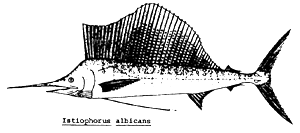
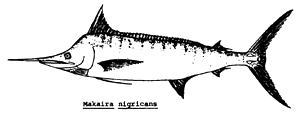
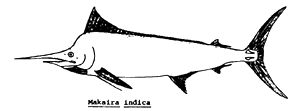
Figure 2.4 Principal species of billfish present in the study area (Collette and Nauen, 1983).